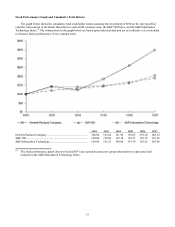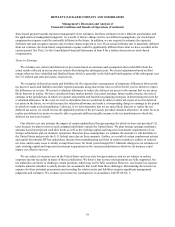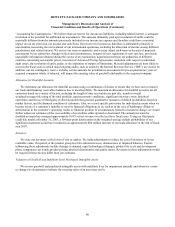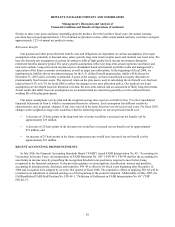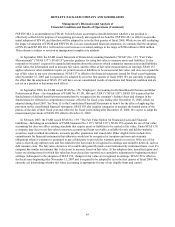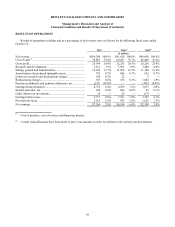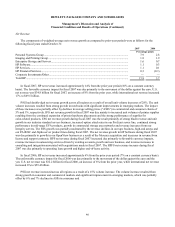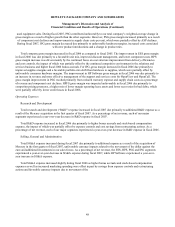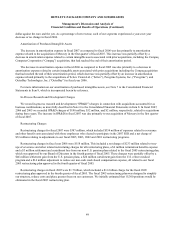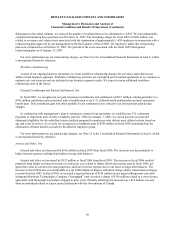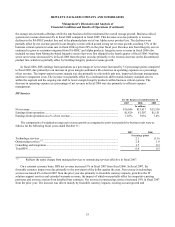HP 2007 Annual Report Download - page 57
Download and view the complete annual report
Please find page 57 of the 2007 HP annual report below. You can navigate through the pages in the report by either clicking on the pages listed below, or by using the keyword search tool below to find specific information within the annual report.HEWLETT-PACKARD COMPANY AND SUBSIDIARIES
Management’s Discussion and Analysis of
Financial Condition and Results of Operations (Continued)
FSP FIN 48-1 is an amendment to FIN 48. It clarifies how an enterprise should determine whether a tax position is
effectively settled for the purpose of recognizing previously unrecognized tax benefits. FSP FIN 48-1 is effective upon the
initial adoption of FIN 48, and therefore will be adopted by us in the first quarter of fiscal 2008. While we are still evaluating
the impact of adoption of FIN 48 and FSP FIN 48-1 on our consolidated financial statements, we estimate that the adoption
of FIN 48 and FSP FIN 48-1 will result in a net increase to retained earnings in the range of $500 million to $900 million.
This estimate is subject to revision as management completes its analysis.
In September 2006, the FASB issued Statement of Financial Accounting Standards (“SFAS”) No. 157, “Fair Value
Measurements” (“SFAS 157”). SFAS 157 provides guidance for using fair value to measure assets and liabilities. It also
responds to investors’ requests for expanded information about the extent to which companies measure assets and liabilities
at fair value, the information used to measure fair value, and the effect of fair value measurements on earnings. SFAS 157
applies whenever other standards require (or permit) assets or liabilities to be measured at fair value, and does not expand the
use of fair value in any new circumstances. SFAS 157 is effective for financial statements issued for fiscal years beginning
after November 15, 2007 and is required to be adopted by us in the first quarter of fiscal 2009. We are currently evaluating
the effect that the adoption of SFAS 157 will have on our consolidated results of operations and financial condition and are
not yet in a position to determine such effects.
In September 2006, the FASB issued SFAS No. 158, “Employers’ Accounting for Defined Benefit Pension and Other
Postretirement Plans—An Amendment of FASB No. 87, 88, 106 and 132(R)” (“SFAS 158”). SFAS 158 requires that the
funded status of defined benefit postretirement plans be recognized on the company’ s balance sheet and changes in the
funded status be reflected in comprehensive income, effective for fiscal years ending after December 15, 2006, which we
adopted during fiscal 2007. See Note 15 to the Consolidated Financial Statements in Item 8 for the effect of applying this
provision on the consolidated financial statements. SFAS 158 also requires companies to measure the funded status of the
plan as of the date of their fiscal year end, effective for fiscal years ending after December 15, 2008. We expect to adopt the
measurement provisions of SFAS 158 effective October 31, 2009.
In February 2007, the FASB issued SFAS No. 159, “The Fair Value Option for Financial Assets and Financial
Liabilities—Including an amendment of FASB Statement No. 115” (“SFAS 159”). SFAS 159 expands the use of fair value
accounting but does not affect existing standards that require assets or liabilities to be carried at fair value. Under SFAS 159,
a company may elect to use fair value to measure accounts and loans receivable, available-for-sale and held-to-maturity
securities, equity method investments, accounts payable, guarantees and issued debt. Other eligible items include firm
commitments for financial instruments that otherwise would not be recognized at inception and non-cash warranty
obligations where a warrantor is permitted to pay a third party to provide the warranty goods or services. If the use of fair
value is elected, any upfront costs and fees related to the item must be recognized in earnings and cannotbe deferred, such as
debt issuance costs. The fair value election is irrevocable and generally made on an instrument-by-instrument basis, even if a
company has similar instruments that it elects not to measure based on fair value. At the adoption date, unrealized gains and
losses on existing items for which fair value has been elected are reported as a cumulative adjustment to beginning retained
earnings. Subsequent to the adoption of SFAS 159, changes in fair value are recognized in earnings. SFAS 159 is effective
for fiscal years beginning after November 15, 2007 and is required to be adopted by us in the first quarter of fiscal 2009. We
currently are determining whether fair value accounting is appropriate for any of our eligible items and cannot
43


